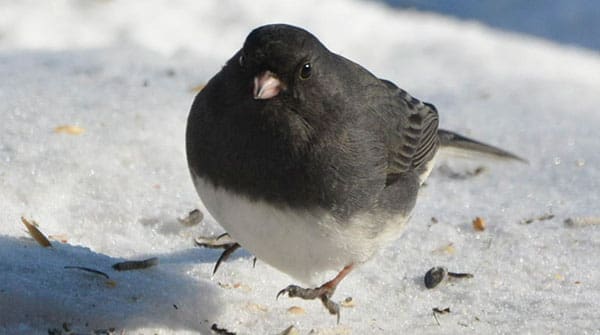Dark-eyed Juncos exploit the feeding habits of other birds to their advantage
 Not to be boastful, but I may have the smartest birds in the world coming to my feeders.
Not to be boastful, but I may have the smartest birds in the world coming to my feeders.
I have, for years, maintained feeding stations and enthusiastically watched the antics of the birds that dropped by. Last year, I noticed that my Dark-eyed Juncos were cleverly using other birds to provide them with food.
Okay, let’s pause for a second for those who aren’t sure what a junco is. A junco is a sparrow that doesn’t look like a sparrow. It spends its winters in southern Canada and the northern U.S., feeding on weed seeds and at feeders. It sports a slate gray plumage, forming a hood over the head and down onto the breast. The white belly and tail feathers and pink bill make it unmistakable.
So back to the matter of finding food …
 Dark-eyed Junco |
| More Nature in a Nutshell |
| Nature is gearing up for another spring
|
| Tips for setting up your bird feeders
|
| Exploring the secret lives of Canada’s snakes
|
I have two feeders with suet in them for the woodpeckers and nuthatches, almost always occupied by these birds with more waiting in the wings, so to speak. Last year, I noticed that the juncos would fly to the ground below the suet feeder to harvest the fallen seeds previously embedded in the suet and subsequently dislodged by the woodpeckers as they fed.
Soon, the juncos learned to fly to the railing well above the ground and directly below the suet feeder for even more seeds and less competition from other juncos and sparrows. At first, they didn’t show up until immediately after a woodpecker or nuthatch was at the feeder, but eventually they learned that they could dislodge the seeds themselves if they clung to the wire cage protecting the suet feeder and poked at the suet block to free the seeds. This poses a challenge since these birds typically feed on the ground, making it quite difficult for them to perch on a vertical wire.
Seeds dropped by the Dark-eyed Juncos in this manner are soon scooped up by other juncos waiting below. Over time, they learned that jays, chickadees, and nuthatches would all drop seeds when feeding on the suet, and they quickly flew to the suet feeders every time any of these birds showed up for dinner – and they were never disappointed for food fell every time!
It was fascinating to watch this behaviour and witness how quickly the birds learned to exploit this food source. Initially, one junco appeared, followed by one or two more, and then eight to ten of them have mastered this method of finding food. The birds completed the entire learning process in less than three days from the first time I noticed it.
When my Dark-eyed Juncos came back last fall, some of them must have been returnees because they inspected the base of the suet feeders even before I had filled them with food. So they have a memory that lasts at least a year – which is sometimes better than mine!
The Blue Jays are another story: they are worse than squirrels for outwitting my attempts to control their eating. Don’t get me wrong, I love to watch jays, but they’re pigs and bullies. No matter what I try, they find a way to outsmart me and eat most of the sunflower seeds and leave the scraps for the other birds. I guess I shouldn’t complain – they are lovely and wonderfully entertaining but sometimes just too darn smart!
Geoff Carpentier is a published author, expedition guide and environmental consultant.
For interview requests, click here.
The opinions expressed by our columnists and contributors are theirs alone and do not inherently or expressly reflect the views of our publication.
© Troy Media
Troy Media is an editorial content provider to media outlets and its own hosted community news outlets across Canada.

